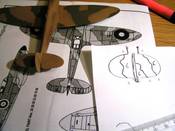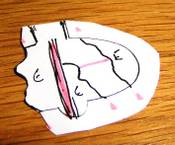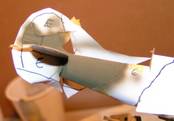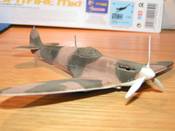1⁄35Paper camouflage masks
4
Comments
Picture 7
Slide the wing masks into place. Use masking tape underneath the wing and at the fuselage to hold the mask in place. Now use your airbrush to mist some water onto the paper mask and then press the mask onto the wing. You may have to do this a few times to settle the mask into place.
Picture 8 Wings finished.
Pictures 9, 10 and 11 Tailplane and fuselage are done in a similar way.
Pictures 12 and 13 Model is now ready for finishing.
Picture 8 Wings finished.
Pictures 9, 10 and 11 Tailplane and fuselage are done in a similar way.
Pictures 12 and 13 Model is now ready for finishing.
Comments
A very interesting and clever technique, thanks for sharing Vince. "You can't have to many Spitfires"
Mal
DEC 01, 2004 - 08:18 AM
I suppose trying this technique will answer the following question, however learning from anothers experience is much more expedient.
I suppose after misting and pressing the mask in place ( a few times if req'd) and allowing for a full drying of the surface to be painted and a partial drying of the paper, it should be good to paint. I'm concerned that if I allow the paper to dry fully, the paper might raise in spots allowing overspray to go under the mask. Ah, I guess I'll just try it. Any comments are appreciated.
JAN 04, 2005 - 12:41 PM
I usually spray paint soon after misting the paper with water - with the mask still slightly damp. If you spray into the painted area away from the masked edge then you will have no problems.
Take a look at some of the wartime pictures of camouflage - they vary a great deal. Some have a hard edge, others soft or a mixture of both. Don't try to get hung up on a 'perfect finish' as the real thing in wartime was far from perfect .
Example of wartime camo pics here;
LINK
JAN 04, 2005 - 11:26 PM
Copyright ©2021 by Vince Haworth. Images also by copyright holder unless otherwise noted. The views and opinions expressed herein are solely the views and opinions of the authors and/or contributors to this Web site and do not necessarily represent the views and/or opinions of AeroScale, KitMaker Network, or Silver Star Enterrpises. Images also by copyright holder unless otherwise noted. Opinions expressed are those of the author(s) and not necessarily those of AeroScale. All rights reserved. Originally published on: 2004-11-30 00:00:00. Unique Reads: 18774















